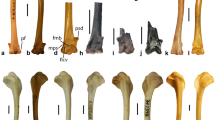Abstract
Messel rails (Messelornithidae) are among the best represented fossil birds and are considered to be the sister taxon of the extant South American sunbittern (Eurypygidae). However, it is shown that the original description of these birds contains several misinterpretations and that the presumed synapomorphies of the taxon (Messelornithidae + Eurypygidae) are not present in Messel rails. Moreover, it is generally assumed that the closest extant relative of sunbitterns is the New Caledonian kagu (Rhynochetidae), and Messel rails lack significant derived characters supporting monophyly of the taxon (Rhynochetidae + Eurypygidae). Derived characters are presented which support sister group relationship between Messelornithidae and the taxon (Rallidae + Heliornithidae).
Kurzfassung
Messelrallen (Messelornithidae) zählen zu den häufigsten fossilen Vögeln und werden für das Schwestertaxon der rezenten Sonnenrallen (Eurypygidae) gehalten. Die Originalbeschreibung dieser Vögel enthält allerdings einige Fehlinterpretationen und die mutmaßlichen Synapomorphien des Taxons (Messelornithidae + Eurypygidae) konnten für die Messelrallen nicht bestätigt werden. Es wird darüber hinaus im allgemeinen angenommen, daß der nächste lebende Verwandte der Sonnenrallen der neukaledonische Kagu (Rhynochetidae) ist und Messelrallen fehlen wichtige Synapomorphien des Taxon (Rhynochetidae + Eurypygidae). Abgeleitete Merkmale werden beschrieben, die eine Schwestergruppenbeziehung zwischen den Messelornithidae und dem Taxon (Rallidae + Heliornithidae) begründen.
Similar content being viewed by others
References
Baumel, J. J. &Witmer, L. M. (1993): Osteologia. — In: J. J.Baumel, A. S.King, J. E.Breazile, H. E.Evans & J. C.Vanden Berge [Eds], Handbook of avian anatomy: Nomina Anatomica Avium. — Publications of the Nuttall Ornithological Club,23: 45–132, 18 text-figs; Cambridge, Mass.
Cracraft, J. (1982): Phylogenetic relationships and transantarctic biogeography of some gruiform birds. — Geobios, mém. spéc.,6: 393–402, 1 text-fig.; Lyon.
Cracraft, J. (2001): Avian evolution, Gondwana biogeography and the Cretaceous-Tertiary mass extinction event. — Proc. R. Soc. Lond. (B),268: 459–469, 6 text-figs; London.
Feduccia, A. (1996): The Origin and Evolution of birds. — 1–420; New Haven and London (Yale University Press).
Hesse, A. (1988a): Die †Messelornithidae — eine neue Familie der Kranichartigen (Aves: Gruiformes: Rhynocheti) aus dem Tertiär Europas und Nordamerikas. — J. Ornithol.,129: 83–95, 2 pls; Berlin.
Hesse, A. (1988b): Taxonomie der Ordnung Gruiformes (Aves) nach osteologischen morphologischen Kriterien unter besonderer Berücksichtigung der †Messelornithidae Hesse 1988. — Cour. Forsch.-Inst. Senckenberg,107: 235–247, 3 pls; Frankfurt.
Hesse, A. (1990): Die Beschreibung der Messelornithidae (Aves: Gruiformes: Rhynocheti) aus dem Alttertiär Europas und Nordamerikas. — Cour. Forsch.-Inst. Senckenberg,128: 1–176, 15 text-figs, 12 pls; Frankfurt.
Hesse, A. (1992): A new species ofMesselornis (Aves: Gruiformes: Messelornithidae) from the Middle Eocene Green River Formation. — In: K. E.Campbell [Ed], Papers in Avian Paleontology honoring Pierce Brodkorb. — Los Angeles Co. Mus. Nat. Hist., Sci. Ser.,36: 171–178, 10 text-figs; Los Angeles.
Houde, P. (1988): Palaeognathous birds from the early Tertiary of the Northern Hemisphere. — Publications of the Nuttall Ornithological Club,22: 1–148, 41 text-figs, 26 tabs; Cambridge, Mass.
Houde, P. (1994): Evolution of the Heliornithidae: Reciprocal illumination by morphology, biogeography and DNA hybridization (Aves, Gruiformes). — Cladistics,10: 1–19, 9 text-figs, 2 tabs; Westport, Conn..
Houde, P., Cooper, A., Leslie, E., Strand, A. E. &Montaño, G. A. (1997): Phylogeny and Evolution of 12S rDNA in Gruiformes (Aves). — In:D. P. Mindell [Ed], Avian Molecular Evolution and Systematics: 121–158, 14 text-figs; San Diego, (Academic Press).
Livezey, B. C. (1998): A phylogenetic analysis of the Gruiformes (Aves) based on morphological characters, with an emphasis on the rails (Rallidae). — Phil. Trans. Roy. Soc. Lond., B,353: 2077–2151, 14 text-figs, 4 tabs; London.
Livezey, B. C. &Zusi, R. L. (2001): Higher-order phylogenetics of modern Aves based on comparative anatomy. — Netherl. J. Zool.,51: 179–205, 3 text-figs; Leiden.
Mayr, G. (2002): On the osteology and phylogenetic affinities of the Pseudasturidae — Lower Eocene stem-group representatives of parrots (Aves, Psittaciformes). — Zool. J. Linn. Soc.,136: 715–729, 9 text-figs; London.
Mayr, G. &Ericson, P. (in press): Evidence for a sister group relationship between the Madagascan mesites (Mesitornithidae) and cuckoos (Cuculidae). — Senck. biol.; Frankfurt.
Mayr, G. &Smith, R. (2001): Ducks, rails, and limicoline waders (Aves: Anseriformes, Gruiformes, Charadriiformes) from the lowermost Oligocene of Belgium. — Géobios,34: 547–561, 7 text-figs; Lyon.
Mourer-Chauviré, C. (1995): The Messelornithidae (Aves: Gruiformes) from the Paleogene of France. — Cour. Forsch.-Inst. Senckenberg,181: 95–105, 2 text-figs, 2 pls, 2 tabs; Frankfurt.
Olson, S. L. (1985): The fossil record of birds. — In: D. S.Farner, J. R.King & K. C.Parkes [Eds], Avian Biology,8: 79–238, 11 text-figs; New York (Academic Press).
Peters, D. S. (1991): Zoogeographical relationships of the Eocene avifauna from Messel (Germany). — In:B. D. Bell, R. O. Cossee, J. E. C. Flux, B. D. Heather, R. A. Hitchmough, C. J. R. Robertson &M. J. Williams [Eds], Acta XX Congressus Internationalis Ornithologici: 572–577; Christchurch (New Zealand Ornithological Congress Trust Board).
Sibley, C. G. &Ahlquist, J. E. (1990): Phylogeny and classification of birds: A study in molecular evolution. — 1–976, 385 text-figs, 20 tabs; New Haven and London (Yale University Press).
Strauch, J. G. (1978): The phylogeny of the Charadriiformes (Aves): a new estimate using the method of character compatibility analysis. — Trans. zool. Soc. Lond.,34: 263–345, 36 text-figs, 2 tabs; London.
Author information
Authors and Affiliations
Corresponding author
Rights and permissions
About this article
Cite this article
Mayr, G. Phylogenetic relationships of the early Tertiary Messel rails (Aves, Messelornithidae). Senckenbergiana lethaea 84, 317–322 (2004). https://doi.org/10.1007/BF03043474
Received:
Accepted:
Issue Date:
DOI: https://doi.org/10.1007/BF03043474




